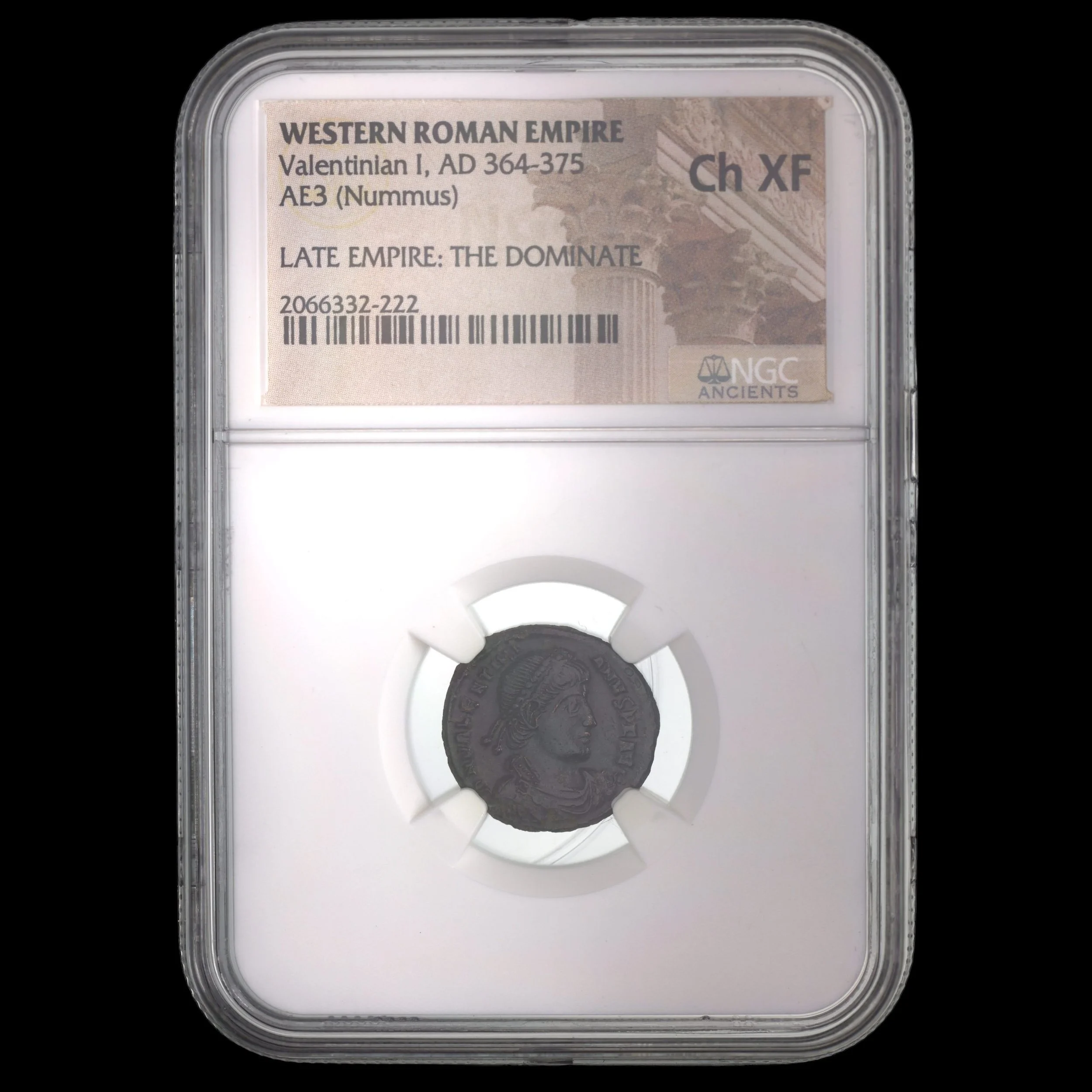 Image 1 of 9
Image 1 of 9

 Image 2 of 9
Image 2 of 9

 Image 3 of 9
Image 3 of 9

 Image 4 of 9
Image 4 of 9

 Image 5 of 9
Image 5 of 9

 Image 6 of 9
Image 6 of 9

 Image 7 of 9
Image 7 of 9

 Image 8 of 9
Image 8 of 9

 Image 9 of 9
Image 9 of 9










Roman Bronze Coin of Valentinian I (about 1,650-1,661 years ago)
The coins shown are representative examples of the grade and type, but not the actual specimens for sale. For details on NGC’s grading standards and definitions, please refer to our NGC Grading page
This bronze coin was issued during the reign of Emperor Valentinian I, who ruled the Western Roman Empire from 364 to 375 CE. Known for his military background and traditional Roman values, Valentinian sought to strengthen the empire's defenses during a period of increasing external pressures along multiple frontiers.
Coin Description:
Front side: Portrait of Emperor Valentinian I facing right, wearing a pearl diadem and imperial robes, with his name and titles in Latin around the edge.
Back side: Likely features common late Roman imagery such as the emperor standing with military standards, Victory crowning the emperor, or possibly the "GLORIA ROMANORVM" (Glory of the Romans) design.
Technical Details:
Bronze alloy composition
Denomination: Likely an AE3 (medium-sized bronze coin in the late Roman monetary system)
Weight: Approximately 2-3 grams
Diameter: Approximately 18-20 mm
NGC Certified for authentication and preservation
Minted between 364-375 CE
Condition as specified by NGC certification
Historical Significance: Valentinian I represents the practical soldier-emperor that the Roman Empire increasingly needed in the 4th century. After being acclaimed emperor, he immediately divided administrative responsibilities with his brother Valens, taking control of the Western provinces while Valens managed the East. Ruling primarily from Mediolanum (modern Milan, Italy), Valentinian focused on strengthening frontier defenses against Germanic tribes along the Rhine and Danube rivers. Despite his limited formal education, he was known for religious tolerance within a Christian framework. His reign was characterized by military campaigns and infrastructure projects to secure Roman borders, though his infamous temper reportedly contributed to his death—suffering a stroke while angrily addressing Quadi tribal ambassadors in 375 CE.
The coins shown are representative examples of the grade and type, but not the actual specimens for sale. For details on NGC’s grading standards and definitions, please refer to our NGC Grading page
This bronze coin was issued during the reign of Emperor Valentinian I, who ruled the Western Roman Empire from 364 to 375 CE. Known for his military background and traditional Roman values, Valentinian sought to strengthen the empire's defenses during a period of increasing external pressures along multiple frontiers.
Coin Description:
Front side: Portrait of Emperor Valentinian I facing right, wearing a pearl diadem and imperial robes, with his name and titles in Latin around the edge.
Back side: Likely features common late Roman imagery such as the emperor standing with military standards, Victory crowning the emperor, or possibly the "GLORIA ROMANORVM" (Glory of the Romans) design.
Technical Details:
Bronze alloy composition
Denomination: Likely an AE3 (medium-sized bronze coin in the late Roman monetary system)
Weight: Approximately 2-3 grams
Diameter: Approximately 18-20 mm
NGC Certified for authentication and preservation
Minted between 364-375 CE
Condition as specified by NGC certification
Historical Significance: Valentinian I represents the practical soldier-emperor that the Roman Empire increasingly needed in the 4th century. After being acclaimed emperor, he immediately divided administrative responsibilities with his brother Valens, taking control of the Western provinces while Valens managed the East. Ruling primarily from Mediolanum (modern Milan, Italy), Valentinian focused on strengthening frontier defenses against Germanic tribes along the Rhine and Danube rivers. Despite his limited formal education, he was known for religious tolerance within a Christian framework. His reign was characterized by military campaigns and infrastructure projects to secure Roman borders, though his infamous temper reportedly contributed to his death—suffering a stroke while angrily addressing Quadi tribal ambassadors in 375 CE.




























